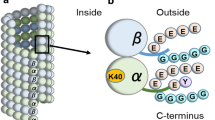Summary
Microtubule arrays in developing spermatogenous cells of pteridophytes have unique microtubule organizing centers and post-translation modifications of tubulin. Sensitivity of these arrays to the microtubule-destabilizing effects of the mitotic disrupter herbicides was examined by immunofluorescence, transmission and immunogold electron microscopy. Acetylated, stabilized arrays, such as the spline, and microtubules of the basal bodies and flagella are formed after the final mitotic division and are resistant to these herbicides. Non-acetylated, dynamic arrays that exist prior to the final mitosis, such as interphase and mitotic arrays, are eliminated by all of these herbicides, with symptomology (arrested prometaphase, lobed nuclei, irregular cell plate formation) similar to that observed in other land plants. The only exception to the instability of these mitotic microtubule arrays are the few microtubules that are collected by kinetochores into short tufts. The presence of structurally-distinguishable MTOCs, such as the blepharoplast, did not confer resistance, despite the anchoring of the minus ends of the microtubules. Simultaneous treatment with herbicide and 5-bromodeoxyuridine (BrdU), with subsequent detection with anti-BrdU of cells that had gone through S-phase during the BrdU incubation, reveals that only acetylated arrays formed prior to herbicide treatment are resistant. These data indicate that only actively polymerizing, dynamic microtubule arrays are sensitive to the destabilizing effects of the mitotic disrupter herbicides.
Similar content being viewed by others
Abbreviations
- MTOC:
-
microtubule organizing center
- BrdU:
-
5-bromodeoxyuridine
References
Åstrom H (1992) Acetylated alpha-tubulin in the pollen tube microtubules. Cell Biol Int Rep 16: 871–881
Cleary AL, Hardham AR (1988) Depolymerization of microtubule arrays in root tip cells by oryzalin and their recovery with modified nucleation patterns. Can J Bot 66: 2353–2366
Gundersen GG, Kalnoski MH, Bulinski JC (1984) Distinct populations of microtubules: tyrosinated and non-tyrosinated alpha tubulin are distributed differentially in vivo. Cell 38: 779–789
Gunning BES, Sammut M (1990) Rearrangements of microtubules involved in establishing cell division planes start immediately after DNA synthesis and are completed just before mitosis. Plant Cell 2: 137–145
Hepler PK (1972) Differential inhibition of cell division in microspores ofMarsilea with colchicine and isopropyl N-phenylcarbamate. J Cell Biol 55: 112a (abstract)
Hoffman JC, Vaughn KC (1994) Mitotic disrupter herbicides act by a single mechanism but vary in efficacy. Protoplasma 179: 16–25
— — (1995a) Post translational tubulin modifications in spermatogenous cells of the pteridophyteCeratopteris richardii. Protoplasma 186: 169–182
— — (1995b) Using the developing spermatogenous cells ofCeratopteris to unlock the mysteries of the plant cytoskeleton. Int J Plant Sci 15: 346–358
— —, Joshi HC (1994) Structural and immunocytochemical characterization of microtubule organizing centers in pteridophyte spermatogenous cells. Protoplasma 179: 146–160
James SW, Lefebvre PA (1988) Mutants resistant to anti-microtubule herbicides map to a locus on the uni linkage group inChlamydomonas reinhardtii. Genetics 118: 141–147
—, Siflow CD, Stroom P, Lefebvre PA (1993) A mutation in the alphal tubulin gene ofChlamydomonas reinhardtii confers resistance to anti-microtubule herbicides. J Cell Sci 106: 209–218
Kerr GP, Carter JV (1988) Microtubules of higher plants contain acetylated alpha tubulin. J Cell Biol 107: 670a (abstract)
Kozminski KG, Diener DR, Rosenbaum JL (1993) High level expression of nonacetylatable alpha-tubulin inChlamydomonas reinhardtii. Cell Motil Cytoskeleton 25: 158–170
LeDizet M, Piperno G (1986) Cytoplasmic microtubules containing acetylated alpha tubulin inChlamydomonas reinhardtii. spatial arrangements and properties. J Cell Biol 103: 13–22
Lehnen LP, Vaughn KC (1991) Immunofluorescence and electron microscopic investigations of the effects of dithiopyr on onion root tips. Pestic Biochem Physiol 40: 58–67
Myles DG, Hepler PK (1982) Shaping of the sperm nucleus inMarsilea: a distinction between factors responsible for shape generation and shape determination. Dev Biol 90: 238–252
Vaughn KC, Lehnen LP (1991) Mitotic disrupter herbicides. Weed Sci 39: 450–457
—, Sherman TD, Renzaglia KS (1993) A centrin homologue is a component of the multilayered structure in bryophytes and pteridophytes. Protoplasma 175: 58–66
Webster DR, Borisy GG (1989) Microtubules are acetylated in domains that turn over slowly. J Cell Sci 92: 58–66
Author information
Authors and Affiliations
Rights and permissions
About this article
Cite this article
Hoffman, J.C., Vaughn, K.C. Spline and flagellar microtubules are resistant to mitotic disrupter herbicides. Protoplasma 192, 57–69 (1996). https://doi.org/10.1007/BF01273245
Received:
Accepted:
Issue Date:
DOI: https://doi.org/10.1007/BF01273245




